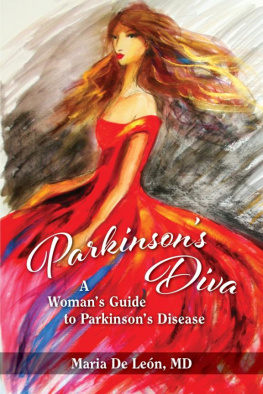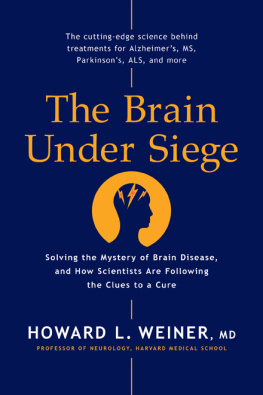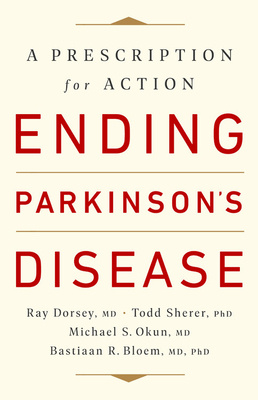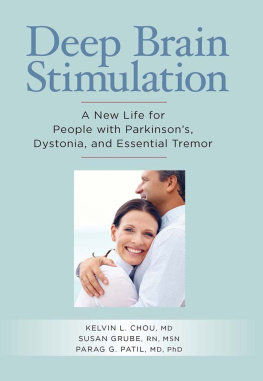Contents
Guide
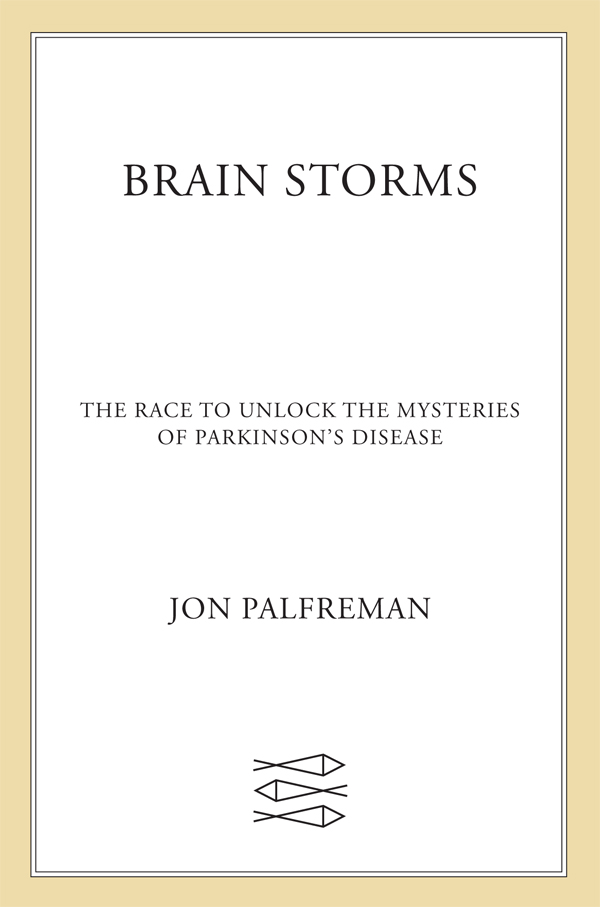

I could not have written this book without the generous advice and assistance of numerous researchers, clinicians, professional colleagues, and fellow people with Parkinsons. My thanks to the many individuals who shared their knowledge, stories, and advice in interviews and e-mails, including Chuck Adler, Jay Alberts, Ron Alterman, Krys Bankiewicz, Roger Barker, Carol Ann Bassett, Sara Batya, Tom Beach, Anders Bjrklund, Bastiaan Bloem, Paul Bolam, DuBois Bowman, Debi Brooks, Patrik Brundin, James Buie, Jean Burns, Jacqueline Burr, Jerry Callahan, Doug Carnine, Linda Carnine, Cuiping Tracy Chen, Chad Christine, Daniel Corcos, Mahlon DeLong, Dennis Dickson, Chris Dobson, Roger Duvoisin, Nancy Egan, Stanley Fahn, Matt Farrer, Jeremiah Favara, Richard Fisher, Michael Fitzgerald, Kim Gannon, Steve Gill, Christopher Goetz, Larry Golbe, Tom Graboys, Dan Grossman, Katrina Gwinn, Zach Hall, John Hardy, Joel Havemann, Dustin Heldman, Hampus Hillerstrom, Fay Horak, Tom Isaacs, Ole Isacson, Dave Iverson, Matt Johnson, Karl Kieburtz, Tuomas Knowles, Jeff Kordower, Walter Koroshetz, Mark Kramer, Rajaraman Krishnan, Nell Lake, Story Landis, Bill Langston, Peter Laufer, Virginia Lee, Andrew Lees, Dan Leventhal, Peter LeWitt, Oded Lieberman, Max Little, Walter Maetzler, Chester Mathis, Helen Matthews, Pietro Mazzoni, James McNames, Karsten Melcher, August Moretti, Robert Nussbaum, Jay Nutt, Michael Okun, Ben Petrick, Elizabeth Eli Pollard, Mihael Polymeropoulos, Pamela Quinn, Sara Riggare, Web Ross, John Rothwell, Joan Samuelson, Pete Schmidt, Todd Sherer, Ludy Shih, Jerry Silbert, Jonathan Solomon, Maria Spillantini, Jon Stamford, Phil Starr, Georg Sternberg, Farah Stockman, A. Jon Stoessl, Carlie Tanner, Barbara Tilley, Alex Tizon, Michele Vendruscolo, Monica Volz, Karen Weintraub, Christine Woodside, Zbigniew Wszolek, and Richard Wyse. Unless otherwise cited in the notes, all quotations are derived from these interviews.
* * *
In a few places, names and identifying characteristics have been altered to protect the privacy of individuals.
In June 2012, I visited the eminent neuroscientist Bill Langston at his home in Los Altos Hills, California. We had met a quarter of a century before, when I had produced a documentary for the PBS series Nova titled The Case of the Frozen Addict. The film told the story of six young drug abusers in San Jose, California, mysteriously struck with the symptoms of Parkinsons disease, a neurodegenerative condition that normally affects the elderly. Bill Langston, then an unknown clinician, discovered the unlucky individuals languishing in psych wards and jail cells and had temporarily reversed their symptoms with the drug L-dopa, the principal treatment prescribed for Parkinsons disease.
Over the next few months, Langston and his colleagues cracked the mystery. The young people, it turned out, had injected a bad batch of synthetic designer heroin. Unfortunately for them, the backstreet chemist whod concocted the drug had made a terrible mistake during the synthesis and inadvertently created a neurotoxic contaminant called MPTP.
While tragic for the victims, this deadly molecule proved of immense scientific importance. Scientists had been hampered in their efforts to study Parkinsons because humans are the only animals to contract it naturally. To make real progress, scientists need ways to study diseases in animalsusing an animal model. MPTP, therefore, changed everything for scientists interested in Parkinsons disease. This neurotoxin, it turned out, could rapidly induce parkinsonism in monkeys, as it had in the six addicts. As Bill Langston put it, MPTP was a bracing tonic Suddenly we had ways to study why cells die in Parkinsons disease. With the animal model, we could test new medicines as fast as you could make them.
Langston went on to become an internationally renowned neuroscientist, founding his own research institute in Sunnyvale, California: the Parkinsons Institute and Clinical Center. My film established my reputation as a documentary producer and science journalist.
That afternoon in Los Altos Hills, Bill and I spent three hours talking about some of the remarkable advances in Parkinsons research that had taken place over the past two decades. The conversation ranged from neural grafting to gene therapy, from novel drugs to therapeutic vaccines, from genetics to neurosurgery. It was fascinating. But this time, ironically, I wasnt there just as a journalist. I had a compelling personal reason for my renewed interest in Parkinsons disease. At the age of sixty, Id contracted the condition myself.
* * *
Id learned my destiny on a cold, dark, rainy January morning in 2011. My doctor, worried about a modest tremor in my left hand, had referred me to the Oregon Health and Science Universitys movement disorder center in Portland. I wasnt particularly worried. My mother had manifested a similar symptom most of her life, caused by a relatively benign condition called essential tremor. I was convinced that the same diagnosis would explain my shaking. A young neurologist named Seth Kareus examined me. After taking my medical history, Seth conducted a series of clinical tests. He asked me to perform various motor tasksrotating my hands back and forth, touching my index finger and thumb together, tapping my foot up and down as quickly as I could. He palpated my muscles in all four limbs, checking for both strength and tone. He tested my reflexes with a reflex hammer. He watched as I tracked a moving object with my eyes. He asked me to walk up and down the hall.
After twenty minutes of tests, he told me I had Parkinsons disease. My symptoms were, so far, mild and confined to the left side of my body, but the malady would inevitably progress, and in time I would need treatment with drugs.
I left the hospital in a state of shock. It took me more than a year to process this news, a year in which I engaged in a series of coping strategies. There was secrecy: the only person I told during the first three months after my diagnosis was my wife. There was denial. I questioned the diagnosis and consulted other neurologists. They confirmed I had Parkinsons disease. There was self-pity. And there was isolation. I didnt reach out to other Parkinsons sufferers. To the contrary, I wanted nothing to do with them. The fragile, bent, trembling figures I observed in neurologists waiting rooms saddened and angered me. Was this really who I would become?
Gradually, I began to think more clearly. Because there was no denying my condition, it made sense to embrace it. I threw myself into reading everything I could about Parkinsons disease and speaking to neuroscientists and clinicians so that I could understand my predicament. Thats what had brought me down to Los Altos Hills in June 2012 to mine Bill Langstons encyclopedic grasp of the field. After all, as a lifelong science journalist who had reported on this disease, I was better placed than most to figure out the state of Parkinsons research and ascertain what kind of future I faced. In a profound sense, understanding Parkinsons disease and finding a cure are now my journalistic beat.
* * *
Parkinsons isnt new. Its odd symptoms have been noticed throughout history. An Egyptian papyrus from the twelfth century B.C. describes an old king who drooled (a symptom of advanced Parkinsons disease). The ancient Indian Ayurvedic texts mention a progressive condition characterized by tremor and lack of movement. And the Greek physician Galen even distinguished two kinds of parkinsonian tremors: resting tremors and action tremors. Leonardo da Vinci observed people whose soul cannot control their movements in spite of the fact that their extremities are shaking continuously. There is a clear reference to the disease in Shakespeares Henry VI, Part 2 when Dick the butcher asks, Why dost thou quiver, man? To which Lord Say replies, The palsy, and not fear, provokes me. And scholars agree that the seventeenth-century philosopher Thomas Hobbes almost certainly suffered from it.


